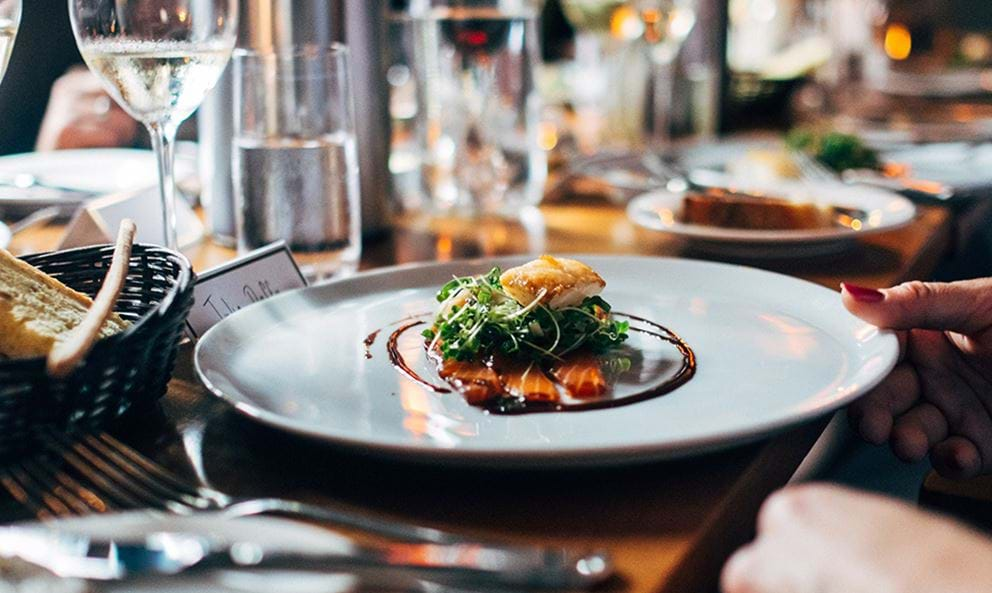Tips to Healthy Eating When Dining Out

Nothing beats going out for a good meal. In fact, one in five UK adults enjoys a meal out (or a tasty takeaway) each week1 .
While it’s perfectly fine to indulge every now and then, if you’re looking for some healthy options from the menu, it can be hard to know what to pick. To make it easier for you to choose the healthier option the next time you join friends for a social dinner – or when you head out for a romantic meal this Valentine’s Day! - here are our top tips for healthy eating when dining out.
Choosing the venue
Where you go to eat might not always be up to you if it's a work do or friend's birthday meal, but when you do have a say in the choice of venue compile a shortlist of local restaurants, then compare their menus online until you find the one with the best choices for your healthy lifestyle
Digest the menu
Once the venue's booked carefully review the menu so you know exactly what you're going to order before you even arrive. If you're unsure of any ingredients or the nutritional values of any dishes take the time to look them up online beforehand. If you have any questions about the menu or if you have any allergies or food intolerances, most restaurants are more than happy to answer queries over the phone before you arrive.
Top 10 Ordering Tips
When the time comes to order your food, keep these top 10 tips in mind:
- Ask for dressing on the side - not just for salads but also on vegetables which can come drizzled in butter.
- If you can't resist the basket of bread, ask for the wholegrain variety rather than white which is high in fibre, vitamins and minerals.
- Request that the chef holds back on adding salt to your food as too much salt can raise blood pressure.2
- Opt for a tomato or vegetable-based sauce instead of creamy options, such as carbonara, which can have a high fat content.
- If your dish comes with rice, ask for boiled instead of fried rice as it's lower in fat and full of vitamins and minerals.3
- If your main comes with a side of chips, ask for thick cut chips which absorb less fat than thin cut chips.4
- Some restaurants may swap your side of chips for sweet potatoes, which are high in fibre, a great source of Vitamin C and B vitamins, and very tasty.5
- Alternatively, you could swap your side of chips or potatoes for a salad or extra vegetables.
- A large glass of wine can contain 228 calories6 so even if there's a bottle for the table to share, opt for still or sparkling water (with a dash of fruit juice) or a diet soda.
- If there's a starter and main course you like, you can have both without blowing your daily limits by asking for a starter-sized portion of the main dish.
Eat slowly
Eating slowly can help you consume fewer calories and digest the food better as chewing slowly helps break down the nutrients from the food making it easier for your body to absorb them.7
Time for dessert
If you fancy something sweet at the end of the meal, a fruit salad or sorbet are generally lower in fat and sugar than most desserts. Or, sharing a dessert between you and your other half doesn’t just halve the calories, it’s pretty romantic too!
1 http://sphr.nihr.ac.uk/one-in-five-uk-adults-eat-meals-out-or-order-takeaways-in-each-week/
2 https://www.nhs.uk/Livewell/Goodfood/Pages/salt.aspx
3 http://healthyeating.sfgate.com/there-health-benefits-boiled-rice-9831.html
4 https://www.nhs.uk/Livewell/men1839/Pages/Dodgytakeaways.aspx
5 https://www.bbcgoodfood.com/howto/guide/health-benefits-sweet-potato
6 https://www.drinkaware.co.uk/alcohol-facts/alcoholic-drinks-units/wine/
7 http://www.healthguidance.org/entry/15737/1/Benefits-of-Eating-Slowly.html
Looking for more quick tips to help improve your health and wellbeing? Check out our Pure Wellbeing series here.


